A perfectly cooked boneless prime rib is the perfect holiday main dish. With its tender texture, rich marbling, and garlic-herb crust, this simple recipe makes any gathering feel like a celebration!
Making prime rib at home is much simpler than you might think. With just a few pantry ingredients and a meat thermometer, you can serve a juicy, restaurant-quality roast at home. This boneless prime rib recipe creates a beautifully browned crust on the outside while keeping the inside tender and flavorful, which is perfect for Christmas dinner, special occasions, or whenever you want to impress your guests without the stress!
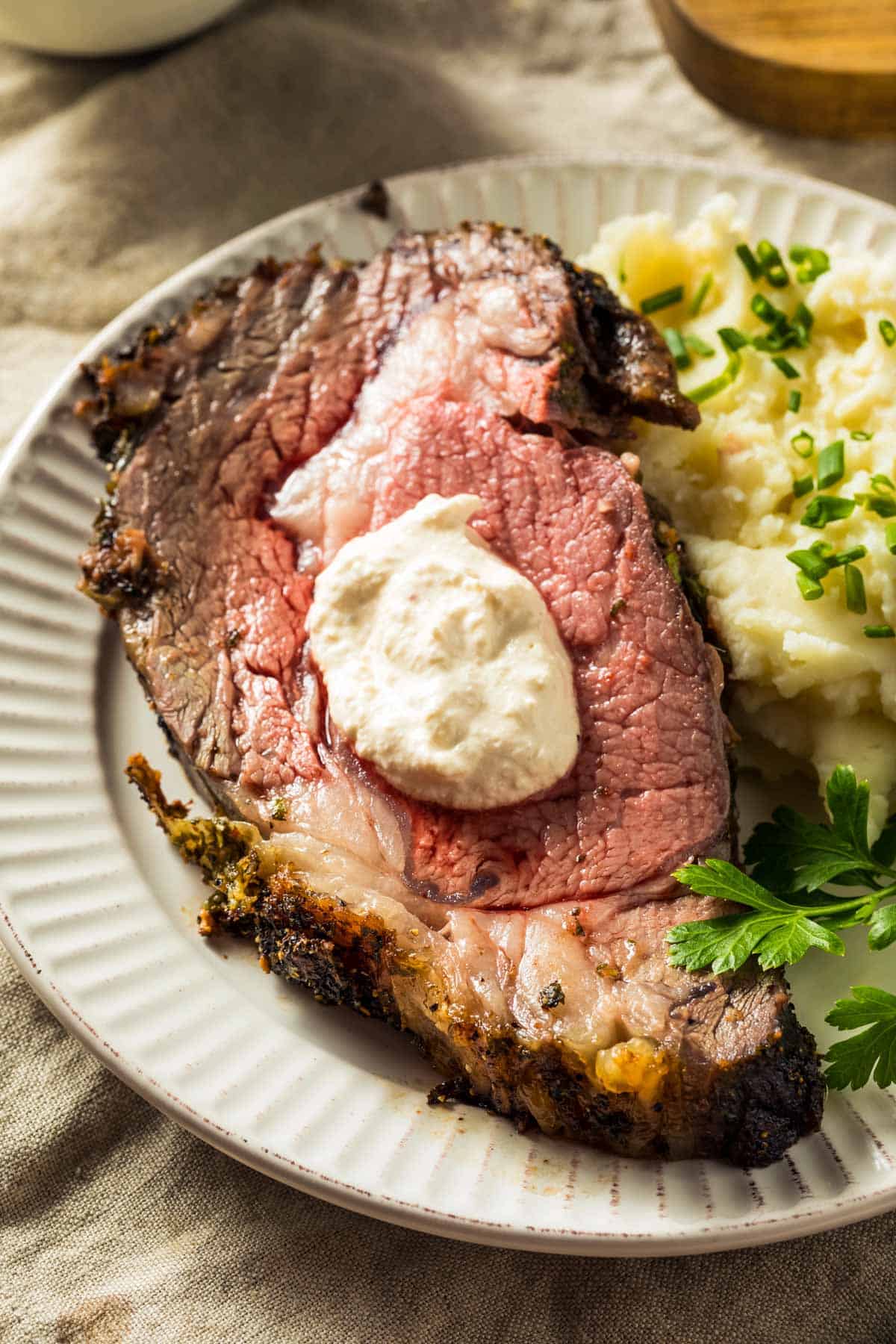
The prime rib recipe is always the one we use whenever we've got a boneless prime rib roast. If we have a bone-in roast, we make our standing rib roast (it's called that because the bones allow it to "stand"). Both rubs can be used interchangeably (this one is herbs and garlic; the other is mustard, garlic, and peppercorn, so choose your favorite)! Both are incredible when served with green beans almondine and/or homemade creamed corn.
Jump to:
Ingredients
This seasoning mix makes a flavorful garlic-herb crust that complements the flavor of the boneless prime rib without overpowering it.
- 1 boneless rib roast (about 8 pounds)
- 4 garlic cloves, minced
- ¼ cup fresh tarragon, chopped
- ¼ cup fresh parsley, chopped
- 3 tablespoons fresh thyme, chopped
- ⅓ cup fresh rosemary, chopped
- 1 tablespoon coarse salt
- 2 teaspoons freshly ground black pepper
- ½ cup unsalted butter, softened
Need to Substitute an Ingredient?
Ask AI for suggestions on how to substitute a particular ingredient.
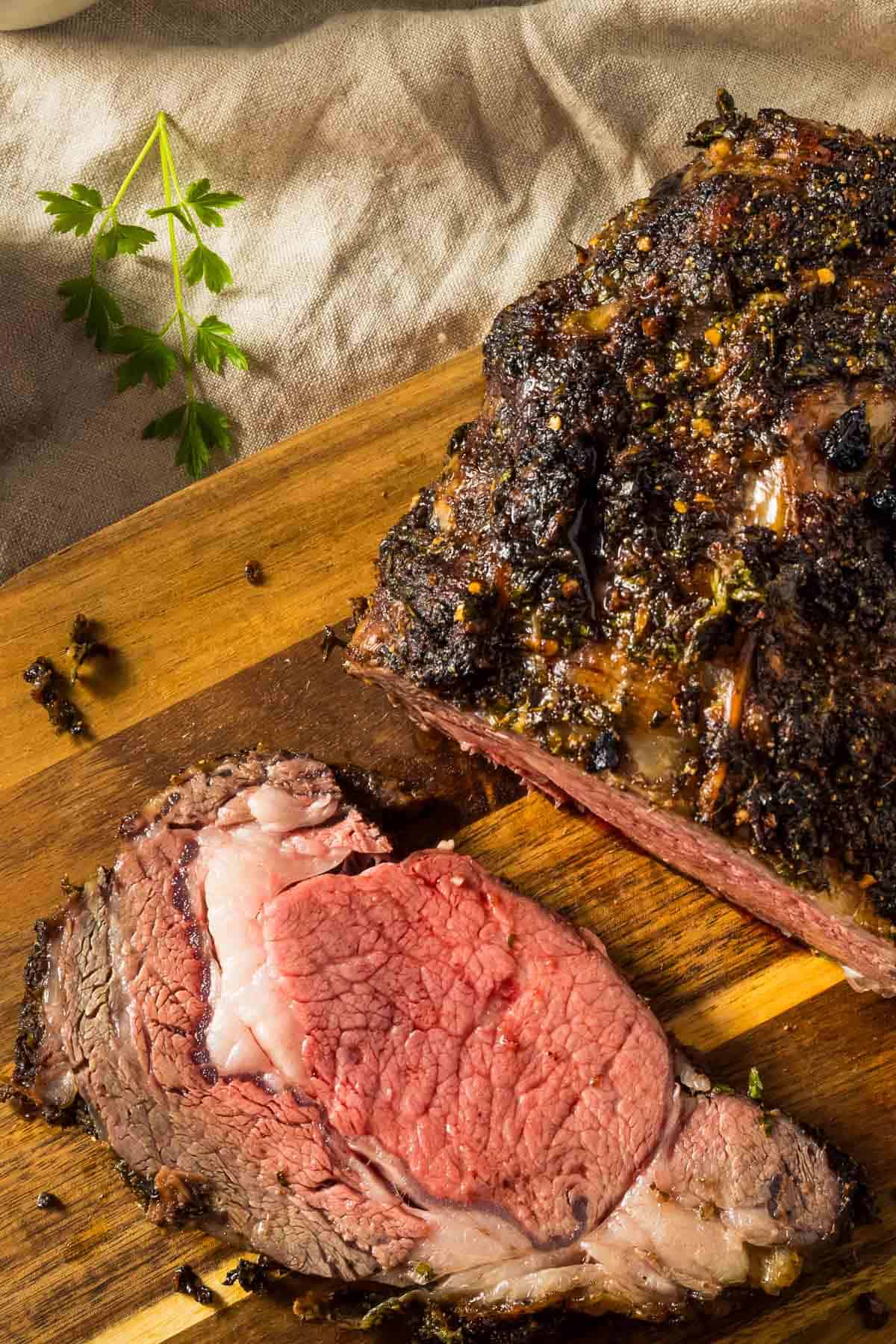
How to Make This Boneless Prime Rib Recipe
- Bring the roast to room temperature: Take the rib roast out of the refrigerator and let it sit uncovered for at least 1 hour (and up to 2 hours). This will help it cook more evenly.
- Preheat the oven: Set the oven to 450°F. Place a rack inside a roasting pan to hold the roast above the drippings.
- Prepare the garlic-herb crust: In a small bowl, mix together the minced garlic, chopped herbs, salt, pepper, and softened butter until it's thoroughly combined.
- Season the roast: Pat the roast dry with paper towels. Rub the garlic-herb butter mixture all over the top and sides of the roast.
- Start with high heat: Place the roast on the rack in the roasting pan. If you're using a meat thermometer, insert it now. Roast at 450°F for 20 minutes to "sear" the outside and help it develop a nicely browned crust.
- Reduce the heat and cook it low & slow: Lower the oven temperature to 325°F. Continue roasting until the internal temperature reaches your desired doneness using the chart below (use a leave-in meat thermometer).
- Rest the roast: Remove the roast from the oven and transfer it to a carving board. Tent it loosely with foil and let it rest for 20-30 minutes. Resting allows the juices to redistribute.
- Carve and serve: Slice it against the grain into thick slices and serve it warm with your favorite sides.
Cooking Time Chart
Cooking times will vary depending on the size of your roast and your oven, so always use a meat thermometer for accuracy. The times below are estimates based on roasting at 450°F for the first 20 minutes, then lowering to 325°F until it's done.
| Roast Weight | Rare (120–125°F) | Medium-Rare (130–135°F) | Medium (140–145°F) |
|---|---|---|---|
| 4 lbs | 1 hr 15 min – 1 hr 30 min | 1 hr 30 min – 1 hr 45 min | 1 hr 45 min – 2 hrs |
| 6 lbs | 1 hr 45 min – 2 hrs | 2 hrs – 2 hrs 15 min | 2 hrs 15 min – 2 hrs 30 min |
| 8 lbs | 2 hrs 15 min – 2 hrs 30 min | 2 hrs 30 min – 2 hrs 45 min | 2 hrs 45 min – 3 hrs |
| 10 lbs | 2 hrs 45 min – 3 hrs | 3 hrs – 3 hrs 15 min | 3 hrs 15 min – 3 hrs 30 min |

Equipment Needed
- Roasting pan with rack: a rack will elevate the roast so air circulates evenly and any drippings collect underneath.
- Leave-in meat thermometer: the single most important tool for perfectly cooked boneless prime rib! This is what makes it completely stress-free. I use one with a built-in alarm that alerts me once the internal temperature of the roast has been reached. I can also see the temperature as it rises, making it much easier to plan when to start cooking side dishes.
- Mixing bowl: for preparing the garlic-herb butter rub.
- Basting brush or spatula: to spread the butter mixture evenly over the roast.
- Sharp carving knife: make sure it's sharp for slicing clean, even portions.
- Cutting board (with juice groove if possible): for resting and carving the roast without making a mess.
- Aluminum foil: to tent the roast while it rests, keeping it warm and juicy.
- Paper towels: for patting the roast dry before seasoning, which helps the crust develop.
Tips for Buying a Boneless Prime Rib
- Know the names - Boneless prime rib may also be labeled as beef rib roast, boneless ribeye roast, boneless rib roast, or standing rib roast (if bone-in). If you're unsure, ask your butcher to confirm you're getting the correct cut.
- Understand USDA grades:
- Prime: Highest grade, heavily marbled, tender, and flavorful. Often found at specialty butchers or online retailers.
- Choice: More widely available, with good marbling and excellent flavor (this is what most home cooks buy).
- Select: Leaner, less marbling, and not recommended for prime rib since it won't be as juicy or tender.
- Portion size: Plan for about:
- ½ pound per person if serving with multiple sides.
- ¾ pound per person for fewer sides.
- 1 pound per person if you want generous portions or leftovers (great for sandwiches).
- Fresh vs. frozen: Fresh is ideal, but frozen prime rib can be a good option if it's bought in advance. Thaw it in the refrigerator for several days before cooking.
- Look for marbling: Choose a roast with even marbling (thin streaks of fat throughout the meat). The fat melts during cooking, and makes for a more juicy and flavorful roast.
- Time your purchase: Around the holidays, boneless rib roasts often go on sale. Buy yours just before cooking, or purchase it early and freeze it if you find a great deal.
- Ask your butcher: A good butcher can trim any excess fat, tie the roast for even cooking, and recommend the right size for the number of guests.
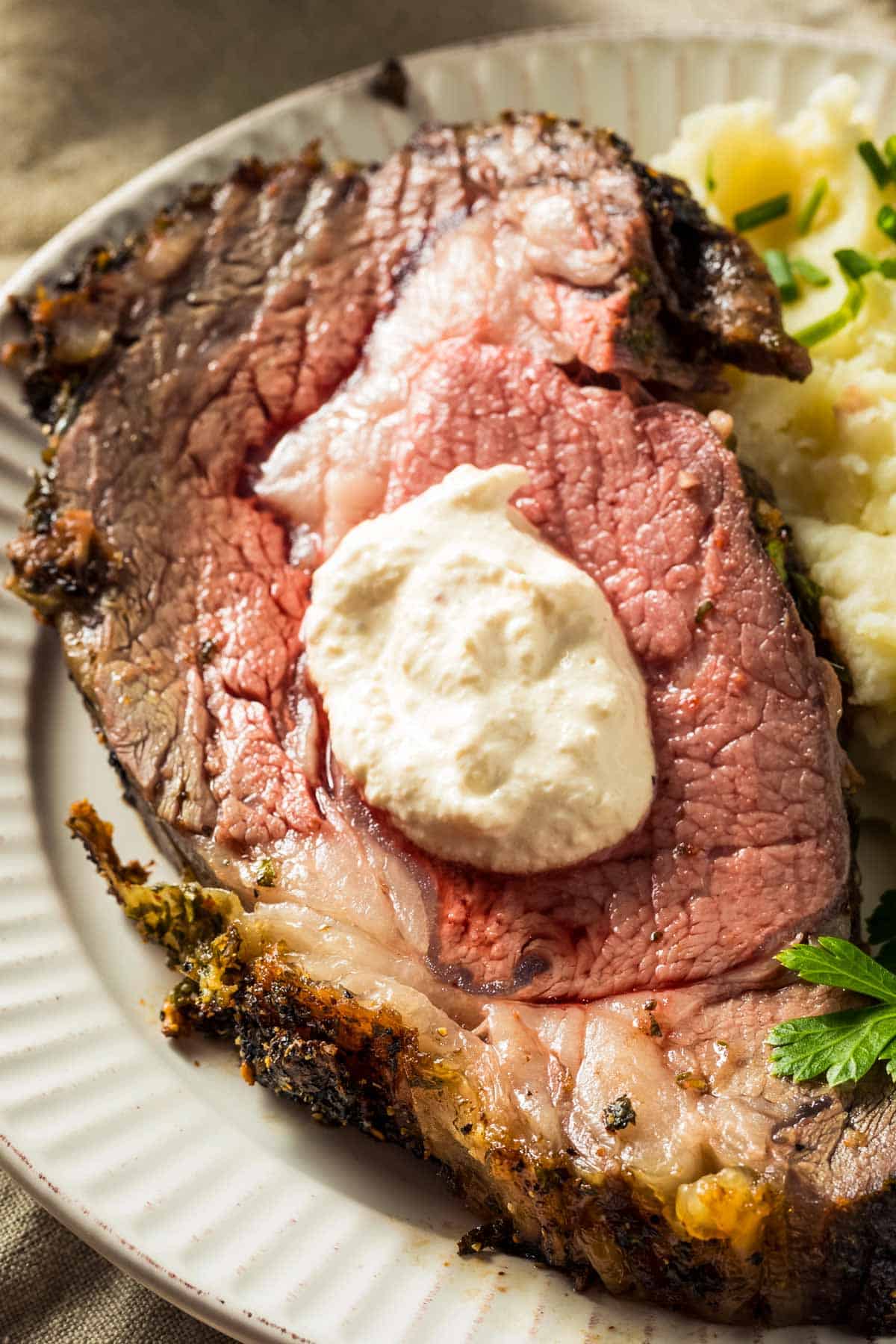
Storage & Reheating
Storage
- Refrigerator: Store leftover boneless prime rib in an airtight container or tightly wrapped in foil for up to 4 days. Slice only what you plan to eat so the rest stays juicy.
- Freezer: Wrap cooled slices tightly in plastic wrap and then foil, or use a freezer-safe container. Freeze for up to 2 months. Thaw overnight in the refrigerator before reheating.
Reheating
Prime rib is best when it's reheated gently. High heat can overcook the meat and make it tough, so go low and slow.
- Oven: Preheat oven to 250°F. Place slices in a baking dish with a splash of beef broth or au jus, cover with foil, and heat until it's warmed through (about 15-20 minutes depending on its thickness).
- Stovetop: Heat slices gently in a skillet with a bit of beef broth over low heat, covering it with a lid to keep the meat from drying out.
- Sous vide (ideal for keeping medium-rare): Seal slices in a vacuum bag or zip-top bag and heat in a 135°F water bath for about 1 hour.
- Microwave: Use low power in short intervals (20-30 seconds), adding a splash of broth and covering with a microwave-safe lid to retain moisture.
The Perfect Pairings
These are the dishes we love to serve with this boneless prime rib recipe:
Frequently Asked Questions
What is boneless prime rib called at the grocery store?
You may see it labeled as boneless rib roast, ribeye roast, beef rib roast, or standing rib roast (if bone-in). When in doubt, ask the butcher to confirm you're getting prime rib.
How much boneless prime rib should I buy per person?
Plan about ½ pound per person if serving lots of sides, ¾ pound per person for a more balanced meal, and 1 pound per person if you want generous servings or leftovers.
What USDA grade should I buy?
Most boneless prime rib sold in grocery stores is USDA Choice, which has great marbling and flavor. Prime grade is higher quality with more marbling, but it usually has to be special ordered or purchased from a butcher.
Do I need to tie a boneless prime rib before cooking?
it's often tied with butcher's twine to help it cook evenly and maintain its shape. Your butcher can do this for you, but your roast will turn out just fine if it's not tied, so don't stress over it (we usually skip this step).
What temperature should boneless prime rib be cooked to?
Rare: 120-125°F
Medium-rare: 130-135°F
Medium: 140-145°F
Always use a meat thermometer for accuracy!
Why is prime rib served rare to medium-rare?
Cooking to medium-rare keeps the fat from melting away, which makes for more juicy, tender meat. The end pieces will naturally cook a bit more, which is great for guests who prefer medium or medium-well (my dad prefers his more toward well-done, so this works perfectly)!
How long do you cook a boneless prime rib?
As a rule of thumb, plan on 15-20 minutes per pound after the initial high-heat sear at 450°F. Always check for doneness with a meat thermometer instead of relying only on time.
Can I make boneless prime rib ahead of time?
It's best served fresh from the oven after a 20-30 minute rest. However, leftovers reheat well (see Storage & Reheating above), so you can definitely make it ahead of time following those instructions.
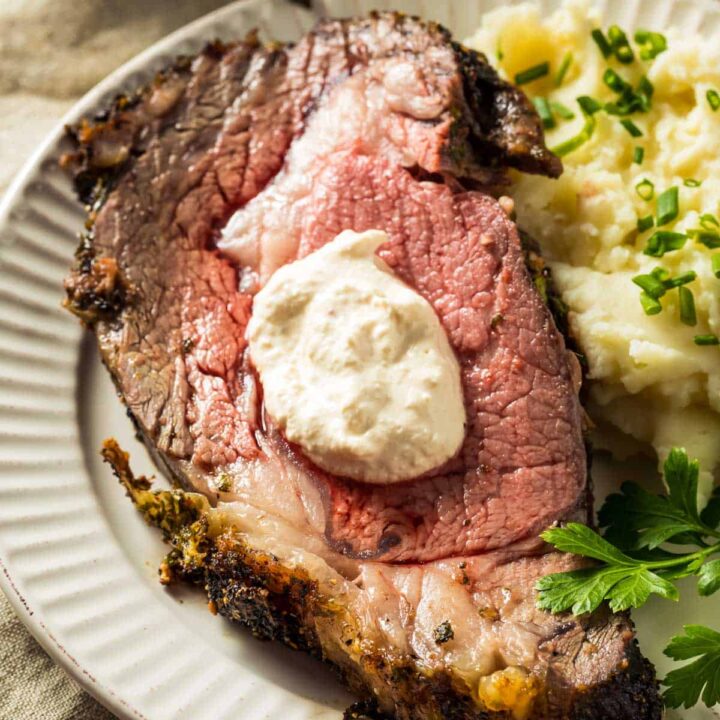
Herb-Crusted Boneless Prime Rib Roast
If you think making prime rib is difficult, I'm here to tell you how simple it is! Make sure to use a leave-in meat thermometer for perfect results every time.
Ingredients
- 1 8-pound boneless rib roast
- 4 garlic cloves, minced
- ¼ cup chopped fresh tarragon
- ¼ cup chopped fresh parsley
- 3 tablespoon chopped fresh thyme
- ⅓ cup chopped fresh rosemary
- 1 tablespoon coarse salt
- 2 teaspoon freshly ground black pepper
- ½ cup butter, softened
Instructions
- Bring the roast to room temperature (let it sit out for at least an hour or longer).
- Preheat your oven to 450°F.
- Mix together the garlic, chopped herbs, salt, pepper and softened butter in a small dish. Rub the mixture all over the top and sides of the roast.
- Place the roast on a rack inside of a roasting pan. Place it in the oven and cook for 20 minutes.
- Reduce the heat to 325°F. Continue cooking the roast until it reaches an internal temperature of 130°F.
- Place the roast on a carving board and tent it lightly with foil. Allow the roast to rest for 20-30 minutes, then carve it and serve.
Notes
Grab the recipe for a horseradish cream sauce (it's in the recipe card).
Nutrition Information:
Yield: 12 Serving Size: 1Amount Per Serving: Calories: 1105Total Fat: 90gSaturated Fat: 38gTrans Fat: 0gUnsaturated Fat: 41gCholesterol: 271mgSodium: 834mgCarbohydrates: 1gFiber: 0gSugar: 0gProtein: 68g
This data was provided and calculated by Nutritionix.
- Sausage Tortellini Soup (Freezer Friendly) - November 18, 2025
- Are Souper Cubes Worth It? (YES!) - November 15, 2025
- Pumpkin Tres Leches Cake (A Make-Ahead Holiday Favorite) - September 29, 2025



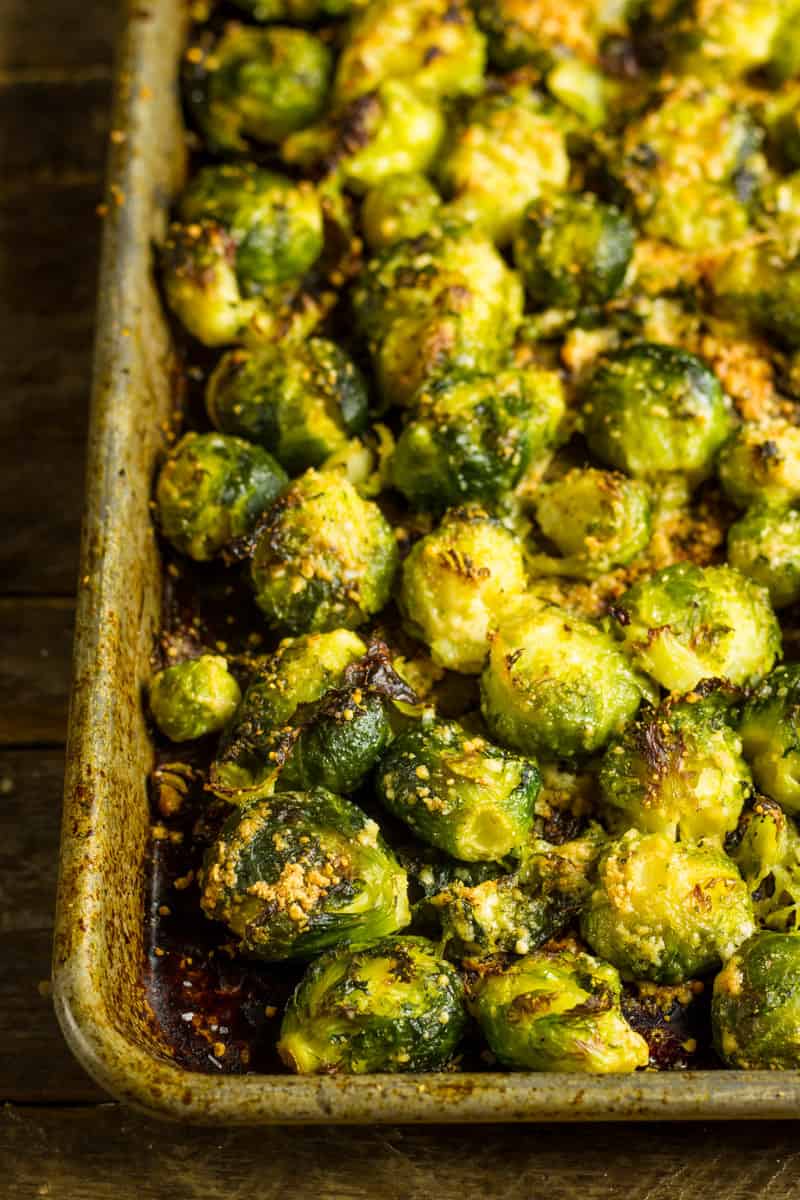


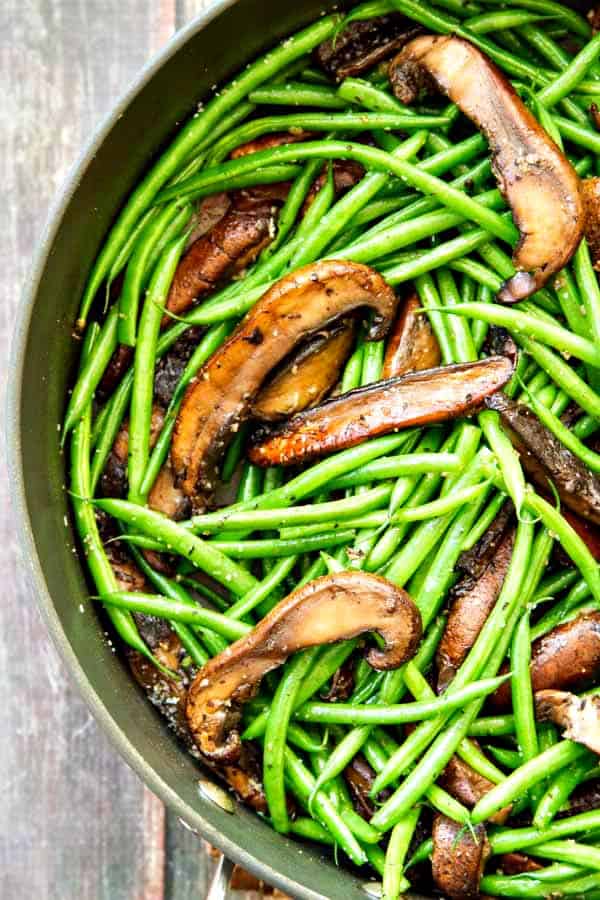

Lauren says
Hi!
How would you adjust this recipe for a bone-in prime rib? I saw the link for the other recipe but this recipe is what we typically use and love! Thank you!!
Monique McArthur says
Follow the instructions exactly except reduce the heat to 350°F. As long as you're cooking to an internal temp of 130°F it should come out perfectly. Hope you enjoy.
Lauren says
@Monique McArthur,
Thank you so much! Merry Christmas
Penny says
I am going to make this for Christmas dinner this year. However, my husband ordered a boneless prime rib for Christmas. We just found out tonight that it will be here Monday. I thought it would be here right before Christmas not a week early. The dilemma is that my husband says that it will be okay until Christmas in the fridge. Since Christmas is a week away, I think we should freeze it. What are your thoughts?
Monique McArthur says
Hi, According to the FDA you should only refrigerate up to 3 to 5 days and freeze anything beyond that.
Donna says
Highly recommend! I’ve been preparing Prime Rib for over 50 years and decided to try a new recipe. So glad I did, won’t go back to my former method. Thank you for sharing!
Brian Williams says
Every year for Christmas or New Year I've made this prime rib recipe since I first met Kristy back in 2014. I was traveling this year so I passed it on to a few friends to try. One family made it yesterday and came into the office raving about how delicious it came out and how easy it was to make. I took the credit of saying I have a great recipe that I got from an even better friend!
Kristy Bernardo says
Aww, love this so much, Brian! Miss you and your wonderful family!
Kathy Ridenour says
I made this for Christmas dinner and it was tender, moist, and very flavorful. This is now saved under my favorites so we can make it every year. I was a little nervous about getting the degree of doneness correct but using a meat thermometer was the key.
Cathy says
Does the butter make it smoke a lot? We have trouble with our vent fan and I have to be careful not to get smoke in the kitchen or all the alarms go off. Other than that... this sounds wonderful!
Kristy Bernardo says
Hi Cathy! I've never noticed it smoking but our vent fan works well, so I'm not sure how to advise you on this. I did happen to see a comment this morning left on the Pinterest pin from someone who made it recently; they said that they made a paste out of the garlic and herbs with olive oil in lieu of the butter. That might be a safer route for you. There's also a link in the post above to a garlic-peppercorn rub that I use often as well. Hopefully one of those will pique your interest. Let me know if you try it!
MARK says
@Kristy Bernardo, put a cup or 2 if water or water/wine in the bottome of the roaster. It keeps the fat from smoking and jump starts you Au Jus.
Susie Palmer says
I made this and it was PERFECT